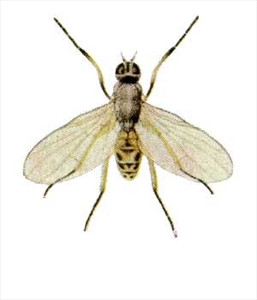- Restricted. Asia, Africa (Seychelles), Oceania. In Australia, Federated States of Micronesia, New Caledonia, Papua New Guinea, Samoa, Tonga, Vanuatu.
- Serious in upland rice and nurseries of lowland rice (up to 4-weeks old), and maize, but also on sorghum, wheat and wild grasses. Maggots attack leaves and bore stems at base causing ‘deadhearts’. Seedlings die or survive if they tiller. The fly is seasonal: dormant when dry.
- Eggs on leaf blades singly or in groups; maggots, yellowish, 9 mm long, pupate in plant base or in soil. Adults 3-3.5 mm long, black head and thorax, yellow abdomen, 2-3 pairs black spots on the back. Spreads on the wing; strong flyer.
- Natural enemies: egg and larval parasitoids; spiders.
- Cultural control: early (or late) sowing, i.e., when relatively dry; increase seedling rate; where rice-maize rotation, plant rice (90-120 kg/ha) 1 month or less after maize; apply N to promote recovery of damaged plants.
- Chemical control: not recommended: uneconomic.





